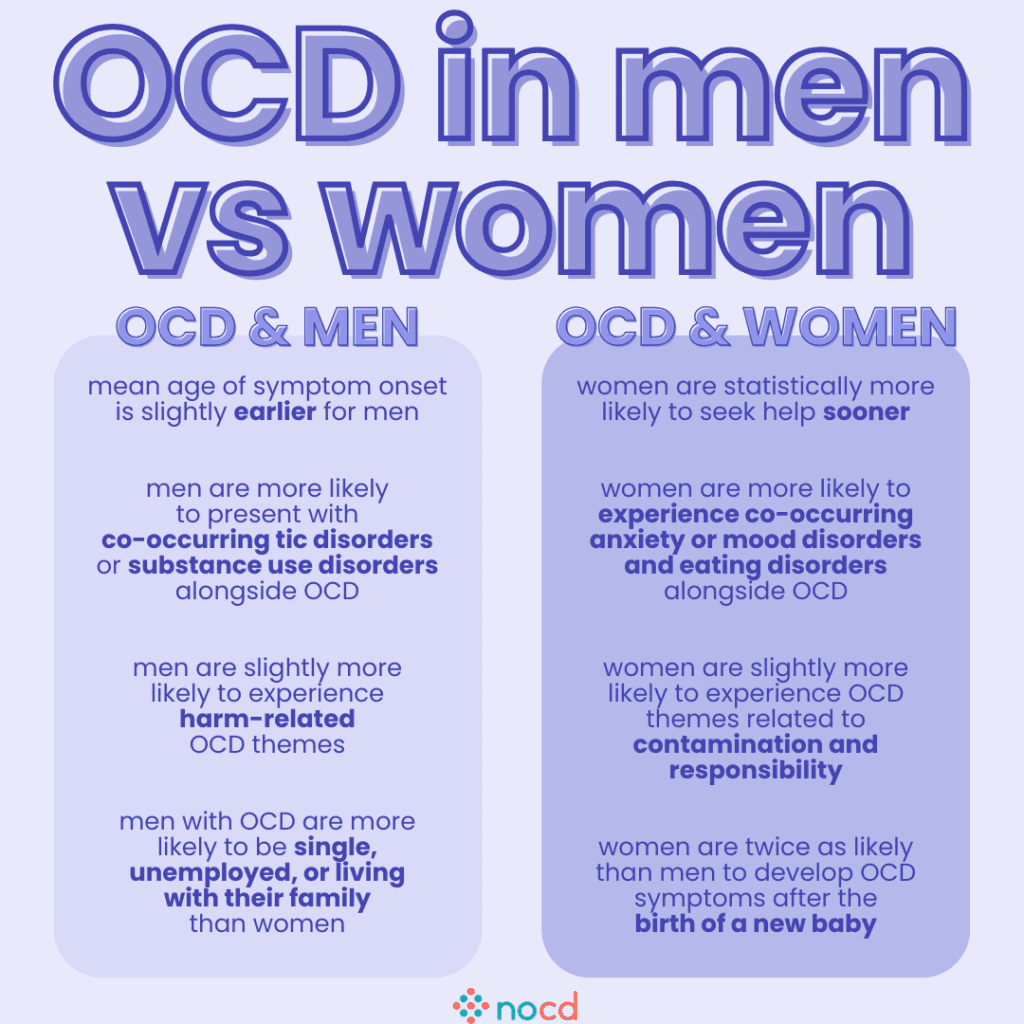Women are almost two times more likely to be diagnosed with obsessive-compulsive disorder (OCD) than men—and their obsessions commonly gravitate towards specific themes like harm and contamination. While OCD sometimes shows up differently in different genders, everyone with OCD can benefit from exposure and response-prevention (ERP) therapy.
It may not surprise you to hear that women face unique challenges when it comes to seeking care for mental health conditions. Women, like other marginalized communities, often face worse access to health services and may experience bias when seeking a diagnosis. This makes it especially important for women who think they may have obsessive-compulsive disorder (OCD) to be aware of OCD symptoms, and the best way to seek support. Understanding what to look for—and who to reach out to—are important first steps for getting accurately diagnosed, and accessing effective treatment.
OCD affects everyone differently. The condition has multiple subtypes, and a wide variety of presentations. Some experts even believe that OCD can show up differently across genders. Keep reading to learn more about navigating OCD as a woman, and how to find the best possible treatment.
Is OCD more common in certain genders?
OCD is a chronic condition characterized by two main symptoms: obsessions (intrusive thoughts, sensations, images, feelings, or urges) and compulsions (repetitive mental or physical actions done to relieve distress from obsessions or to try to prevent a feared event from happening). People with OCD often end up stuck in a vicious cycle of obsessions and compulsions that tends to get worse over time.
According to Tracie Ibrahim, LMFT, CST, Chief Compliance Officer at NOCD, OCD is more prevalent in women. In fact, research reveals that women are 1.6 times more likely to have OCD than men.
Sex differences & OCD: What the research says
(According to Ibrahim, research on OCD has mainly been done with cisgender study participants, so keep that in mind when considering relevant studies.)
- Men with OCD are more likely to start developing symptoms during childhood, but women are more likely to have symptoms that begin during their adolescence and adulthood.
- Women with OCD were more likely than men to have more than one mental health condition.
- Compared to men, women with OCD tend to report higher rates of depression and anxiety.
- Men with OCD are more likely to be single, while women with OCD are more likely to be married.
Find the right OCD therapist for you
All our therapists are licensed and trained in exposure and response prevention therapy (ERP), the gold standard treatment for OCD.
What factors cause OCD symptoms in women?
While the exact causes of OCD are not entirely understood, there are several factors that may increase your risk of developing the condition. For women, in particular, the following factors may play a role in the onset and development of OCD:
Hormonal changes
Hormonal fluctuations can play a role in the development or worsening of OCD symptoms, notes Ibrahim. Research demonstrates that people who menstruate may experience heightened OCD symptoms during menstrual periods, due to changes in estrogen and progesterone. “You can most commonly develop symptoms anywhere from two weeks before or during the menstrual period—or sometimes, both,” says Ibrahim.
Community discussions:
There’s also a link between OCD and menopause. Another study found that the hormonal changes that occur during the postmenopausal period may increase a person’s risk of developing OCD.
Eating disorders
Having an eating disorder—such as orthorexia or binge eating disorder—may be an OCD risk factor for some people. While eating disorders can impact people of all genders, they are more prevalent in women. A 2020 review found that people who have been diagnosed with eating disorders are 18 percent more likely to experience OCD later on in their lives.
Common subtypes of OCD for women
While research shows that OCD disproportionately impacts women, anyone can be impacted by the condition, and symptoms can manifest in a variety of ways.
OCD themes are an equal opportunity offender.
Tracie Ibrahim
That being said, some subtypes seem to be a bit more common among women, including:
Contamination OCD
Research shows that contamination OCD is more prevalent among women. People with contamination OCD experience all-consuming worry about coming into contact with or spreading germs, and often respond to these obsessions by engaging in compulsive behaviors like handwashing, cleaning, or discarding items.
Women who are mothers may experience more specific fears about their children getting sick. “You may freak out about what and who touches your baby,” says Ibrahim.
Relationship OCD
Relationship OCD (ROCD) involves obsessions and compulsions surrounding your close personal relationships, from romantic partnerships to platonic connections. “I have pretty consistently seen more women with relationship OCD,” says April Kilduff, MA, LCPC, LMHC, a licensed therapist and Clinical Trainer at NOCD. Common ROCD compulsions may include constantly asking your partner for reassurance, avoiding a loved one, or compulsively comparing your relationship to others.
Sexual orientation OCD
Sexual orientation OCD involves intrusive thoughts surrounding your sexual orientation. Kilduff says this subtype also seems to be more common in women, based on her clinical experience. She’s seen many women who were filled with intrusive doubts about their sexuality, despite being in healthy, happy relationships with men. She says that OCD creates doubts about these women’s relationships, precisely because they value these partnerships. OCD often seizes on what you care about most. According to Kilduff, “OCD comes in and says, ‘Wait, what if you’re not even into men? What if you need to break up with your boyfriend?’’”
Perinatal/postpartum OCD
Research suggests that OCD is more common in people who are pregnant and postpartum than it is in the general population. Perinatal OCD/postpartum OCD can develop at the beginning of pregnancy, or up to one year after childbirth. With this type of OCD, obsessions and compulsions often revolve around fears of harming or contaminating an infant.
According to Ibrahim, it can be common for OCD to show up during pregnancy, even if you’ve never experienced it before. Researchers are not sure what causes this sudden onset, but many believe there may be a link between pregnancy-related hormonal changes and changes in the brain.
Ibrahim adds that women who are already living with OCD may experience intensified symptoms during or after pregnancy: “It could be a new theme that comes up, or it could be your usual theme, but just flared up.”
How OCD is treated in women
While some OCD subtypes may be more common in women, and the condition seems to disproportionately impact women, the basic concept behind OCD treatment is the same for people of all genders. Exposure and response prevention (ERP) therapy is the most effective way to manage symptoms for all OCD subtypes. This specialized form of cognitive behavioral therapy (CBT) involves two components: careful and intentional exposure to your intrusive thoughts and obsessions, and response prevention techniques to help you learn to refrain from performing compulsions. Because compulsions exacerbate the OCD cycle—making fears feel more real—learning to resist these behaviors is the most effective way to reduce overall symptoms. An ERP therapist can work with you to tailor ERP therapy to your specific needs, based on the obsessions and compulsions you are dealing with.
For example, for mothers who are dealing with intrusive thoughts about being a bad parent, Ibrahim says ERP therapy might involve imaginal scripting. This involves writing out a story about your fear, if it occurred. “It could be as simple as writing about how your kid might not turn out well because of you and the mistakes you make, and just sitting with the discomfort of that possibility,” Ibrahim explains. “We also teach self-compassion because it’s hard to have OCD, but it’s also hard to be a mom. As you learn to accept uncertainty around your fears, you may learn to accept yourself, as well.”
Self-acceptance can be easier when you feel supported by a community of peers. If you’re a mother living with OCD, Ibrahim recommends joining the International OCD Foundation’s (IOCDF) Moms with OCD Special Interest Group for support.
Bottom line
Regardless of your gender, learning to accept uncertainty and discomfort is key to successfully managing OCD. Once you can tolerate that distress, you’ll be able to regain your time from obsessions and compulsions—and start living your life again. You deserve to spend your energy on the things in life that truly matter.
Key takeaways
- Research shows that OCD is more common in women than it is in other genders—however, it is important to note that research on trans and non-binary people with OCD is limited.
- People of all genders can and do experience similar themes of OCD.
- Women commonly experience OCD fears that relate to contamination, relationships, sexual orientation, and their own children.
- People of all genders can treat their OCD effectively with ERP therapy; learning to resist compulsions can help reduce overall symptoms.


